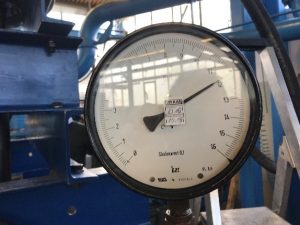What is a Centrifugal Pump?
Before we get into the topic (centrifugal pump inspection), let’s get a little familiar with centrifugal pumps. Centrifugal pumps are mainly used to circulate water in cooling coils, compression chiller cooling towers, return condensate to boiler and in central heating system etc. These pumps are made in different capacities from one to several thousand gallons per minute. Their head is from 2 feet (up to 0.6 meters) to several hundred feet. In this type of pump, energy is transferred to the fluid by centrifugation. These pumps are divided into two types of linear pumps and ground pumps in terms of the type of piping and placement in the circuit.

Types of testing and inspection of pumps:
Industrial products need all kinds of testing and inspection during manufacturing and after manufacturing. There are various pump inspection stations in the manufacture of centrifugal pumps.
Centrifugal Pump Inspection during manufacturing:
1 – Static and dynamic balance test of the impeller:
In all rotating equipment, balance test is the most basic test. No rotating equipment will be able to function properly without performing static and dynamic balancing operations. In the process of producing impellers or rotors, centrifugal pumps inevitably cause unbalance. Imbalance causes impeller lameness and increased dynamic forces, destructive vibrations and reduced bearing life. In static balance, the pump impeller is balanced by being placed between two blades. In dynamic balancing, the pump impeller is balanced at a certain speed by being placed on a special device – dynamic balancing device. Contrary to popular belief, if the pump impeller is statically balanced, it must be dynamically balanced. And in dynamic balance, the pump impeller does not need to be tested at nominal speed, and in fact, the dynamic impeller balance does not depend on its rotation speed.
– Material tests:
The materials used in the pump components may be made of different alloys. They may also have different production methods. There are various tests and inspections for the materials used in the pump. In centrifugal pump inspection process, the purpose of these inspections is to ensure the quality of materials and prevent damage due to defects in materials after manufacture. Important types of material tests are as follows:
A- Chemical analysis test: The purpose of this test is to study the chemical composition of materials in terms of the percentage of different elements in the fabrication of the part. Usually, a sample of the fragment is sent to reference laboratories for chemical analysis and the results are received in the form of report sheets.
B- Mechanical tests: Tensile, hardness and surface smoothness tests are the most important mechanical tests of materials. These tests, like chemical analysis, are usually performed by reference laboratories and the results are reported in the test sheets.
C- Non-destructive NDT tests: A variety of non-destructive tests are performed to detect structural and microscopic defects. A variety of penetrant tests PT, ultrasonic UT, MT magnetic particles, RT radiography may be used for a variety of cast or forged parts. Each of these tests must be performed under its own circumstances, and it is not the case that each piece may or may need to perform all of the above tests.
– Hydrostatic test:
One of the most important tests of pump pressure chambers is hydrostatic testing. This test is usually performed with clean water, and the pump pressure chamber is usually pressurized for 30 minutes at 1.5 times the design pressure. The purpose of this test is to ensure the ability of the shell to withstand design pressure during operation in real conditions.

– Inspections during assembly:
Inspections during assembly refers to a set of inspections that aim to prevent preloading of compression parts and alignment of the set of rotating parts with fixed parts. Each manufacturer usually has specific instructions for the proper assembly of the pumps that inspectors should usually check.
2- post-manufacturing inspections:
– Performance test or hydraulic test:
The main test of the pump, in which all defects may occur during design or construction, is the performance test. Performance testing is an important step in centrifugal pump inspection. In the other word a pump is not tested without doing a performance test! Of course, not all pumps made in a production line may be performance-tested, but they will be tested as a sample. The purpose of this test is to obtain pump performance curves as well as to record parameters such as vibrations, noise or temperature control of bearings.
The performance test is done when the minimum parameters of flow rate, head, absorption amp, voltage, power consumption, external bearing vibrations in three directions, noise level and NPSH are recorded and reported at five points of the performance curve. In the case of NPSH, contractual items may be effective in performing the test. Performance testing is usually performed in accordance with ISO 9906.
– Mechanical Running Test:
In this test, the pump is started at the working point for 4 hours. All parameters related to the performance test are recorded along with the bearing temperature at the beginning of the test. After 4 hours, the above parameters are measured again. The rate of change of the above parameters should be normal or insignificant. Of course, the temperature of the bearings should not increase more than 45 degrees Celsius. The purpose of this test is to ensure the mechanical performance of the pump after assembly.
– Thickness and color adhesion test:
Only after successful completion of the above tests, the device is painted according to the available technical specifications. Paint adhesion test and paint thickness test in different parts of the device are the criteria for proper coating of the device.








